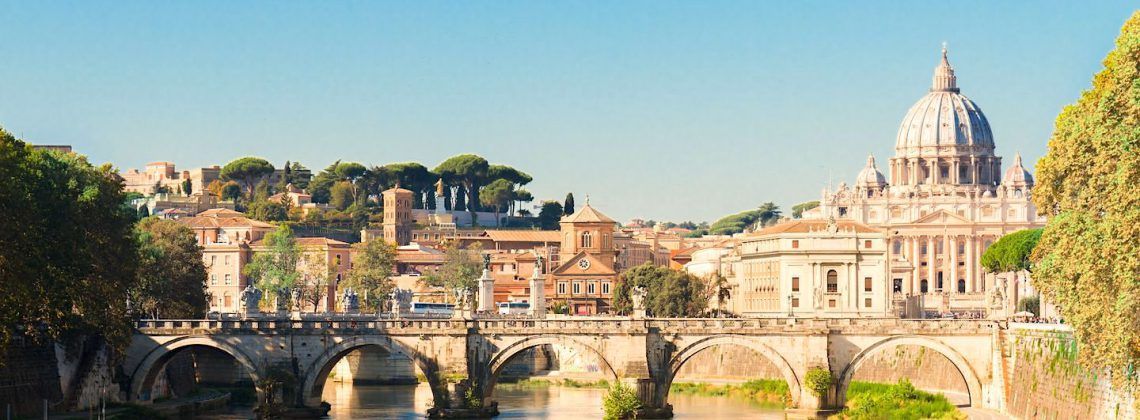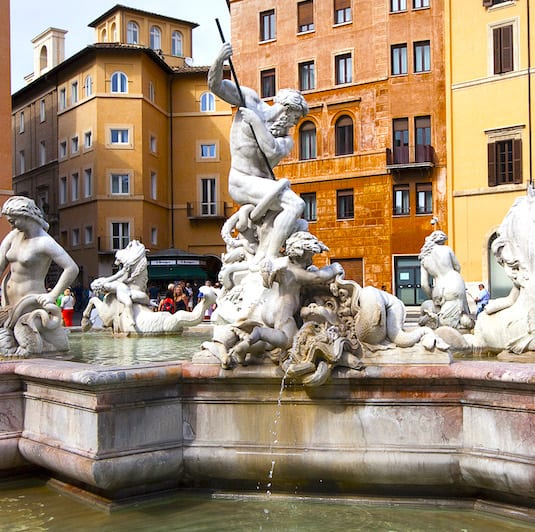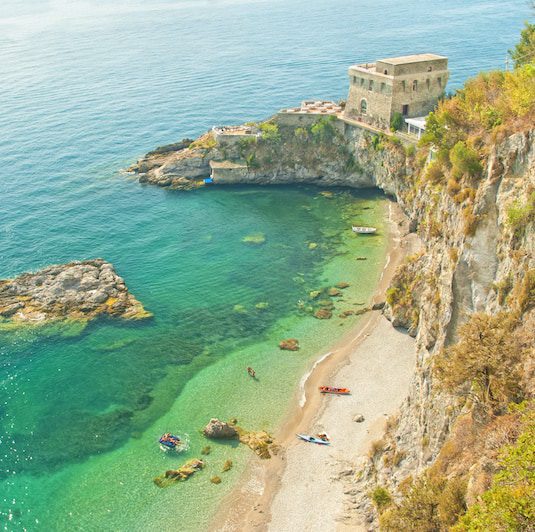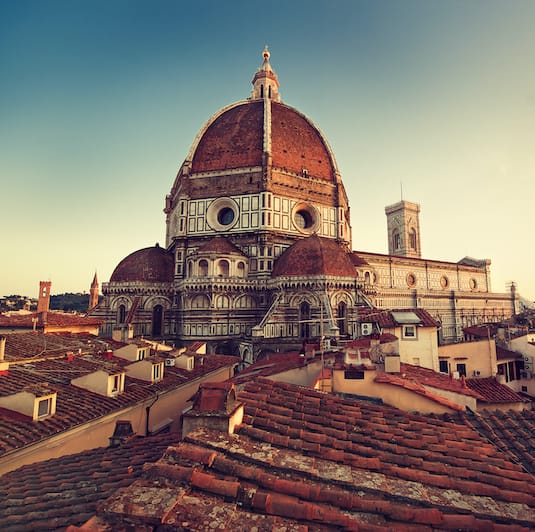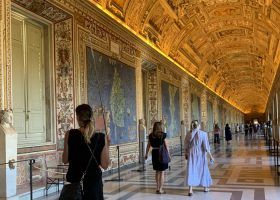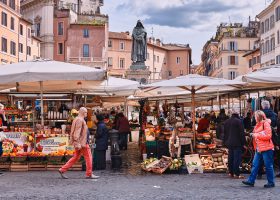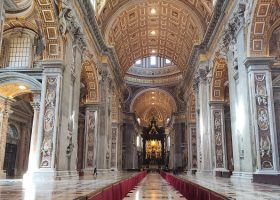Did you know St. Peter’s Basilica is the biggest Catholic Church in the world? That means there’s a lot to see, but don’t worry—we’re here to guide you through it. In this article, Brandon Shaw, a licensed Vatican tour guide, makes sure you see all the main highlights on your visit to this exquisite basilica.
Pro Tip: Planning your visit to St. Peter’s Basilica in Rome? Bookmark this post in your browser so you can easily find it when you’re in the city. See our guide to St. Peter’s Basilica for more planning resources, our top Vatican tours for a memorable trip, and how to climb St. Peter’s Dome.
What To See at St. Peter’s Basilica by a Vatican Guide
For me, there’s no church that compares to St. Peter’s Basilica. It’s the ultimate expression of space, beauty, and monumental grandeur. It also happens to have an amazing history to it.
According to legend, St. Peter was in Rome during the Christian persecution of A.D. 64 under the emperor Nero. He was caught up in the frenzy and martyred by upside-down crucifixion.
The Circus of Nero was located where the church stands today. A circus used to be a place where they held chariot racing. It was in this area that St. Peter was said to be buried in a nearby necropolis, along with other Christians and pagans alike.
In this comprehensive St. Peter’s Basilica guide, you’ll discover the most important artwork for your visit. Without further ado, let’s go discover the basilica!
Not ready to book a tour? See if a Vatican tour is worth it.
17. La Navicella Mosaic by Giotto
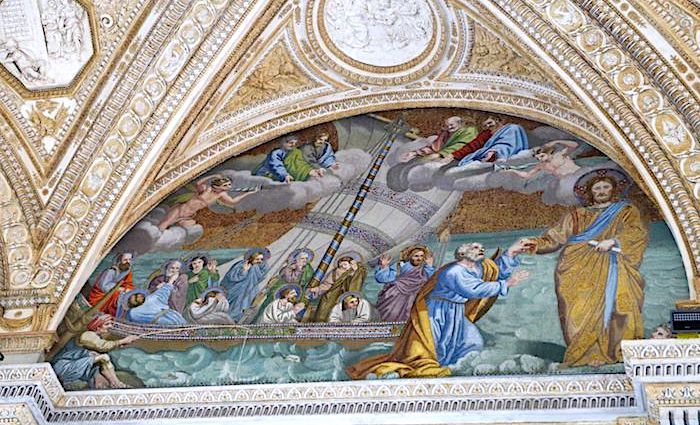
Giotto di Bordone | 1300 | Mosaic | Atrium Before Entering Church
This mosaic was created by the super-famous Giotto di Bondone. Never heard of him? This name probably won’t mean much to you if you haven’t studied Renaissance art history.
Before the Renaissance, paintings were extremely unremarkable with two-dimensional, almost stick figure-like people. There was no expression and no life in their faces—true sadness, like life in general before the Renaissance.
Giotto was the one to revolutionize this and made people look like real people. However, this is actually a mosaic and not a painting. Despite the medium, it still renders that life-like imaging that he introduced and set the scene for centuries to come.
There’s a boat full of St. Peter’s companions looking on in fear as St. Peter faces Jesus, who is walking on the water. The best way to view is right before entering the church itself. Turn around and look up.
16. The Fountains in St. Peter’s Square
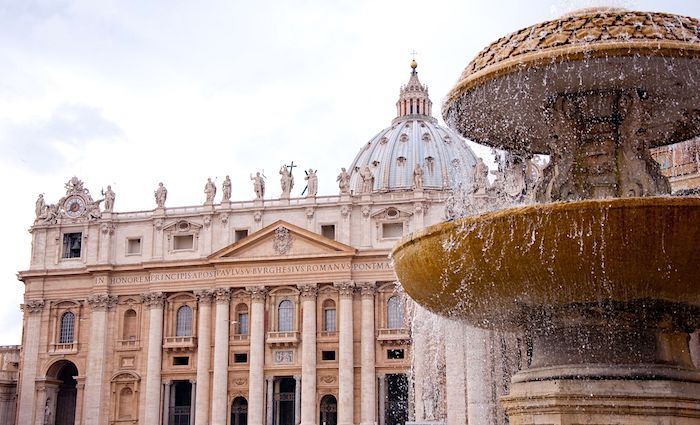
Maderno and Bernini | 1612 and 1677 | White Marble | St. Peter’s Square
The most famous square in the world has two fountains on either side of St. Peter’s Square. Carlo Maderno designed the first fountain on the right in 1612 and also designed the facade of the building.
In 1677, exactly 65 years later, Bernini created a second fountain on the opposite side of the square that is almost identical to Moderno’s design. Today, fountains get very little appreciation unless they can move to the beat of a famous tune.
To fully appreciate the fountain, consider the tools available in the 17th century. We’re not talking about hammers and other tools used to carve the fountain—we’re talking about the water.
If you saw one of these fountains in St. Peter’s Square, you’d probably wonder where they got the water and how they got it to shoot up that high. There’s no river of rushing water nearby. While the Tiber is in fact nearby, it’s at a far lower level and would definitely not allow this fountain to propel water up in the air. It was like magic!
Popular Vatican Tours
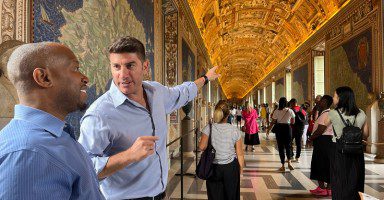
Best Selling Tour
Privileged Entrance Vatican Tour with Sistine Chapel
Without the right access, visiting the Vatican means fighting crowds, long waits, and missing the most significant rooms and works of art. Our privileged entrance tour offers more than just entry—it’s an immersive experience led by a storytelling guide who brings the Vatican to life. Skip the line and explore the Vatican Museums, including the Raphael Rooms, the Sistine Chapel, and St. Peter’s Basilica with engaging insights that make each moment memorable and meaningful.
See Prices
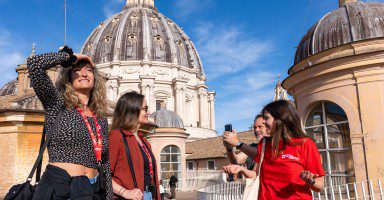
Top Rated Tour
Ultimate St. Peter’s Basilica Dome Climb and Tour with Papal Tombs
Visiting St. Peter’s Basilica and its dome on your own can mean dealing with crowds and waiting in line for hours. Our early-morning tour, led by a captivating local guide, ensures you skip the hassle with privileged access and insider knowledge, including the best times to climb for awe-inspiring views. Explore the stunning Basilica, take in breathtaking panoramas, and descend into the sacred Papal Crypts for a truly immersive experience.
See Prices
Not ready to book a tour? Find out if a Vatican tour is worth it.
15. The Pillars
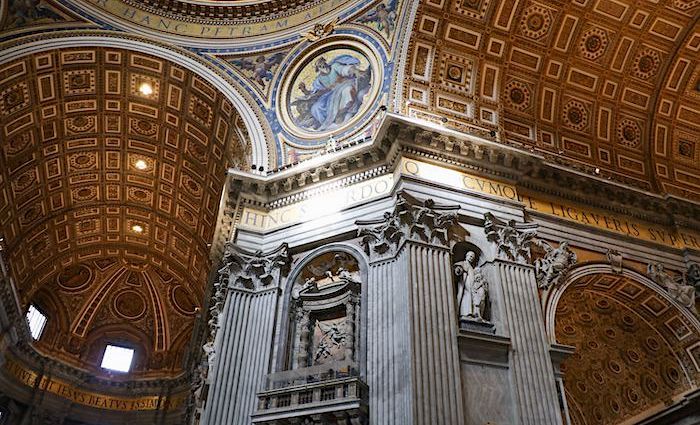
Gian Lorenzo Bernini | 1628 – 1639 | Various Stones | Interior St. Peter’s Basilica by the Dome
To hold up the massive dome of St. Peter’s Basilica, the pillars needed to be gigantic and they are. Donato Bramante started them and Michelangelo finished them. When you look up at them, you’ll notice there are decorations on all four of the pillars.
The illustrious Gian Lorenzo Bernini did the decorations, of course. He carved out the massive niches (33 feet in height) and worked on them between the years 1628 and 1639. Pope Urban VIII commissioned the decorations with the idea of housing the following sacred relics:
- A piece of the spear of the centurion St. Longinus who pierced the side of Jesus while on the cross.
- Fragments of the real cross of Jesus.
- Veronica’s veil with the imprint of Jesus’ face on it.
- The head of St. Andrew.
14. The Ceiling
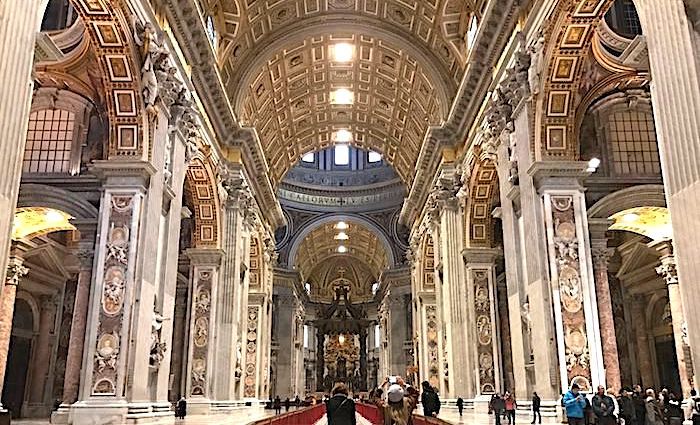
Various Artists | 16th Century | Stone and Gold Leaf | Interior
Once you’re inside, look up. The ceiling is covered in gold leaf and shines as if you’re already in heaven. A common misconception is how big it actually is. Renaissance artists were great at illusions and proportions.
As you look higher up, things should appear smaller to you. However, in St. Peter’s Basilica, everything remains proportional as you look up. That’s because they made the artwork bigger the higher up you go. This is how they got everything to look perfectly proportional. Genius!
To drive this point home, look for the gold band with letters going around the entire church. According to St. Peter’s official website, the gold band measures 10 feet (three meters) high. The letters inside are each about eight feet in height.
Looking with the naked eye from below, you’d swear they were no bigger than a few feet. However, if you manage to see the cleaners up there next to the, you quickly realize just how big they are!
13. St. Peter’s Square
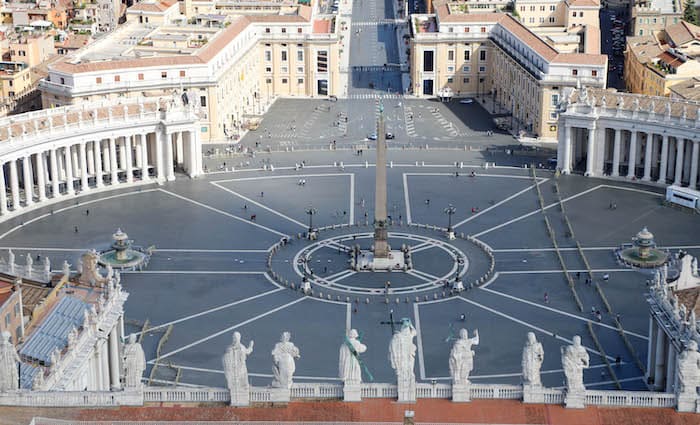
Gian Lorenzo Bernini | 1655 – 1667 | Travertine | St. Peter’s Square
St. Peter’s Square is arguably the most famous square in the world. The idea of the square was first started by Pope Sixtus V (Pontiff from 1585 to 1590) when he ordered the massive Egyptian obelisk moved to the center of the future square.
At the time, it would have been moved to be directly in front of the newly finished basilica. The actual works on the square were initiated by Alexander VII (Pontiff from 1655 to 1667) and finished in 1667. The architect was none other than the famous Bernini.
Design
The square is an elliptical shape and comprising 284 Doric columns four rows deep. The elliptical design was envisioned as a way to embrace all Christians who were entering St. Peter’s Basilica.
Interestingly, if you look at an aerial view of the square, it looks like a keyhole. This goes perfectly with St.Peter whose symbol during the Renaissance and even to this day are the two keys—one for heaven and one for earth. There are also two gigantic fountains on either side of the square, one created by Carlo Maderno and the other by Bernini himself.
Purpose
Historically, the square would have been a meeting point for the feast of Corpus Christi, which was extremely popular at the time of the construction of the square. Today, the square is mainly used for two weekly events.
- The Papal Audience: This takes place every Wednesday morning. The pope blesses the crowd as he travels in the popemobile.
- The Angelus: This takes place every Sunday at noon. The pope from the historical residence of popes (the current pope doesn’t live there) gives a blessing to the crowd below.
12. The Dome
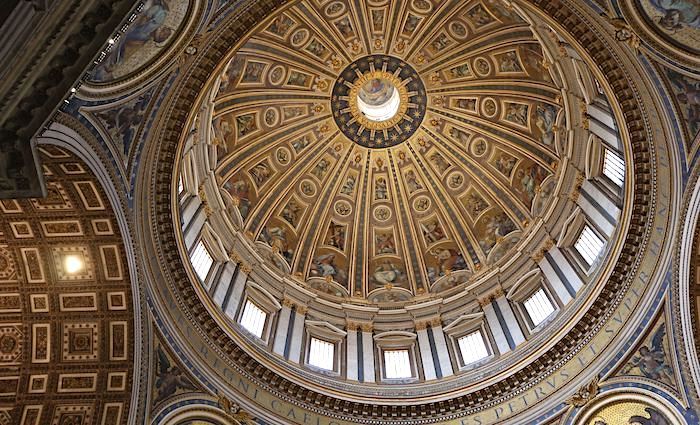
Michelangelo | Throughout 16th Century | Various Stone | Interior
Michelangelo began working on the dome at the ripe old age of 72. To say the dome is massive is an understatement. Michelangelo, who was already rich by this time, refused payment. He worked only to give, “honor to St. Peter, glory to God, and for the salvation of his soul.”
St. Peter’s Basilica’s dome was inspired by that of the Pantheon. Its structure was also inspired by Brunelleschi’s Duomo di Firenze. It bears the distinction of being the tallest dome in the world and it is a prominent feature of Rome’s skyline.
The dome is so tall that you could fit the statue of liberty inside it. Remember that this was built over 400 years ago. The exact dimensions of St. Peter’s Dome are 448.1 feet tall (136.5 meters).
If you want to enjoy what is likely the best view in all of Rome, you should definitely climb St. Peter’s Dome. Just make sure you aren’t claustrophobic, since the passageway leading up gets narrower the higher up you go. The view makes it all worthwhile, though! Find out everything you need to know about how to climb St. Peter’s Dome.
11. Statue of St. Peter
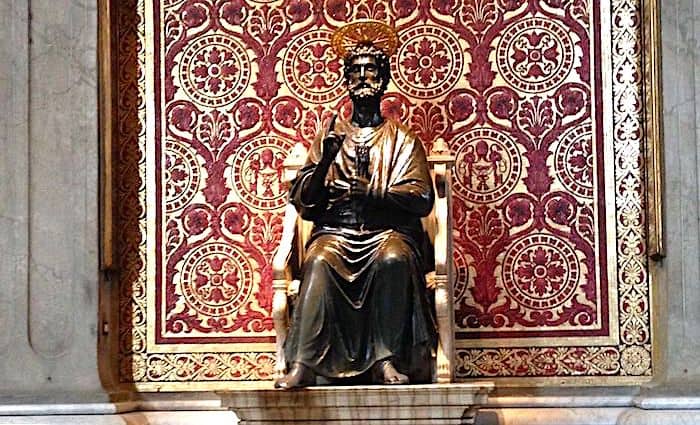
Arnolfo di Cambio? | 1245 – 1250 | Bronze | Interior
As you near the Baldacchino by Bernini, you might notice a line forming on your right-hand side. That is a line of people who are waiting to touch the foot of the statue of St. Peter as a blessing.
According to the official website, the date of this statue is not clear, nor is the person who created it. Many attribute it to Arnolfo di Cambio in the 13th century, but we are not sure.
Tradition over the centuries has been to rub his right foot as a blessing. When you get close, you’ll see that due to the constant rubbing, his toes have completely worn away! Now people have started rubbing his left foot as well!
On June 29th, the feast of St. Peter, this statue is dressed in pontifical clothes including the fisherman’s ring and the papal tiara. Personally, it seems a bit odd to dress up a statue, but who am I to challenge centuries of tradition?
Popular Rome Tours
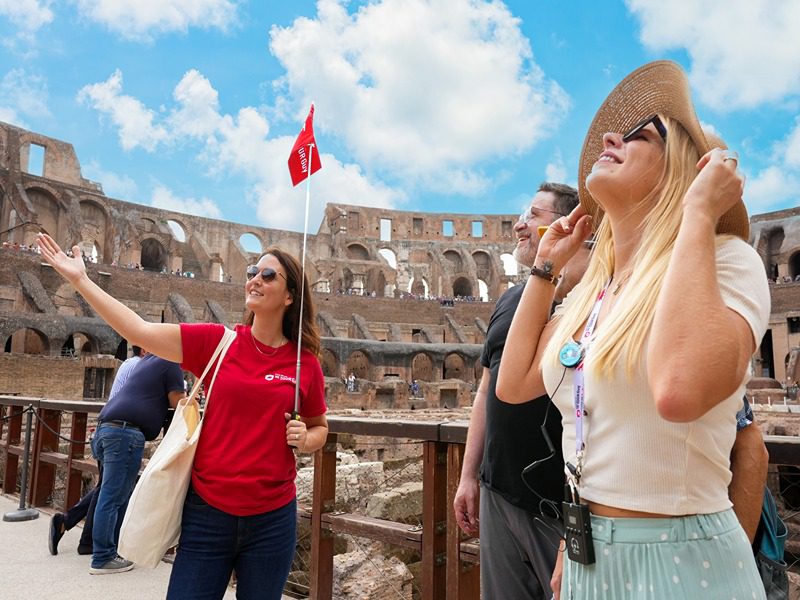
Best-Selling Tour
Rome in a Day Tour with Colosseum and Vatican Museums
Seeing the best of Rome in a single day might seem like a big undertaking, but our expertly designed tour makes it effortless with skip-the-line tickets, included transportation, and engaging guides to lead the way. In just 7 hours, you’ll visit renowned sites like the Sistine Chapel, Colosseum, Trevi Fountain, and Pantheon. With fascinating stories at every stop, you can skip the stress and immerse yourself in the vibrant heritage and culture of Rome all in one remarkable day.
See Prices
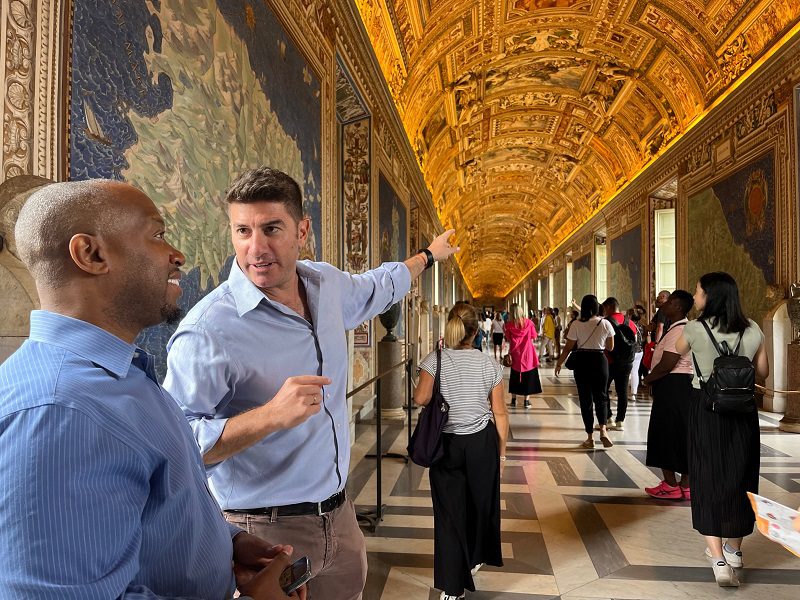
Best Price!
Privileged Entrance Vatican Tour with Sistine Chapel
Without the right access, visiting the Vatican means fighting crowds, long waits, and missing the most significant rooms and works of art. Our privileged entrance tour offers more than just entry—it’s an immersive experience led by a storytelling guide who brings the Vatican to life. Skip the line and explore the Vatican Museums, including the Raphael Rooms and the Sistine Chapel, with engaging insights that make each moment memorable and meaningful.
See Prices
Not ready to book a tour? Check out our best Rome tours to take and why.
10. Tomb of Innocent XI
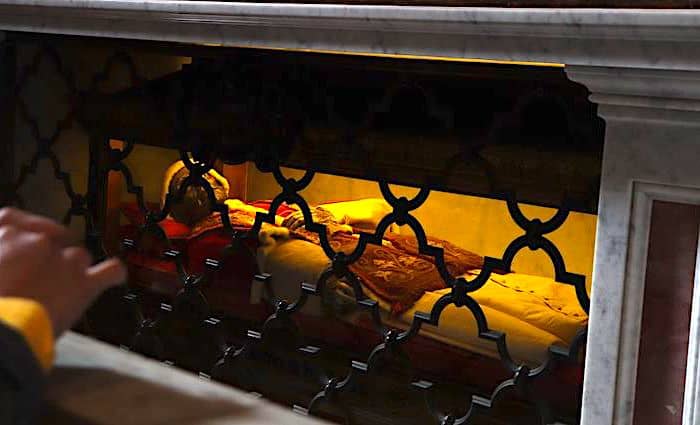
Innocent XI stands out as one of the most important popes of the 17th century. He possessed superior morals and shunned nepotism and corruption at a time when both of these attributes plagued the papacy.
His involvement in the victory of Austria against the Ottoman Empire was key in stopping the spread of Islam into Western Europe. Curiously, he is buried in full view for all to see inside the church.
He is fully clothed and has a mask over his face and hands so that you cannot see his bones. You’ll find him right below the painting (mosaic, see below) of the Transfiguration by Raphael.
Curious how a new Pope is selected? Check out our article on What Happens When a Pope Passes Away?
9. Holy Mass
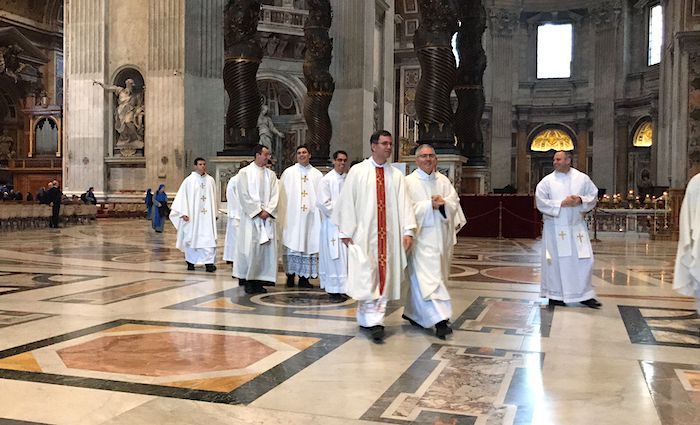
Many people ask me if they can attend mass at St. Peter’s Basilica. Of course, you can! It’s a functioning church. I actually highly recommend that you do it if possible. Here are the times:
- 8:30 am: At the chapel of the Sacrament
- 9 am: At the altar of St. Joseph
- 10 am: At the altar of St. Joseph
- 11 am: At the altar of St. Joseph
- 12 pm: At the altar of St. Joseph
- 5 pm: At the chapel under the Cathedra of St. Peter
8. St. Peter’s Throne
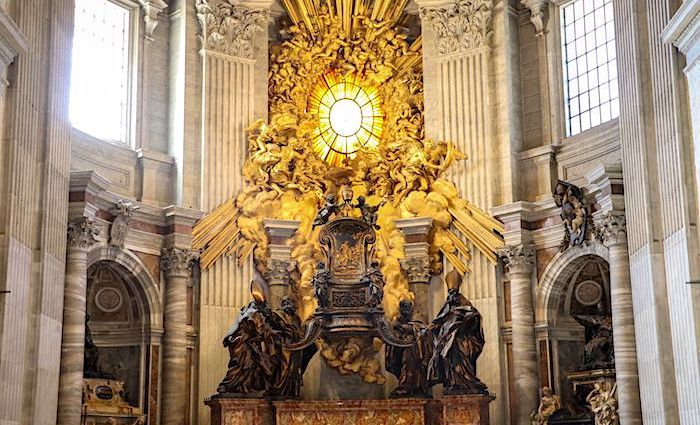
Gian Lorenzo Bernini | 1658 – 1666 | Bronze | Interior
This is the ultimate baroque altar! Look at the power, the movement, and the color: that is what baroque art stands for. It is called the cathedra or throne where St. Peter supposedly sat and gave instructions to the Christians of Rome.
The bronze monument is actually covering a wood and ivory cathedra, which many believed was the real throne. It has now been proven by the church that the wooden throne is actually from 875.
At that time, Charles the Bald gave the throne to Pope John VIII. The cathedra, which is 21ft ( 7m) high, is covered in gilded bronze. The bronze sculpture is surrounded by “Doctors” of the Latin and Greek church: St. Augustine, St. Ambrosius, St. Athanasius, and St. John Chrysostom.
Above this, Bernini added a window in brown glass with a white dove in the middle. As the sun sets, it lets in a beautiful light, which I never fail to admire when I visit the church. This altar is at the complete opposite end of the entrance to the church. It’s also here where you can attend mass every day at 5 pm.
7. La Porta Santa (Holy Door)
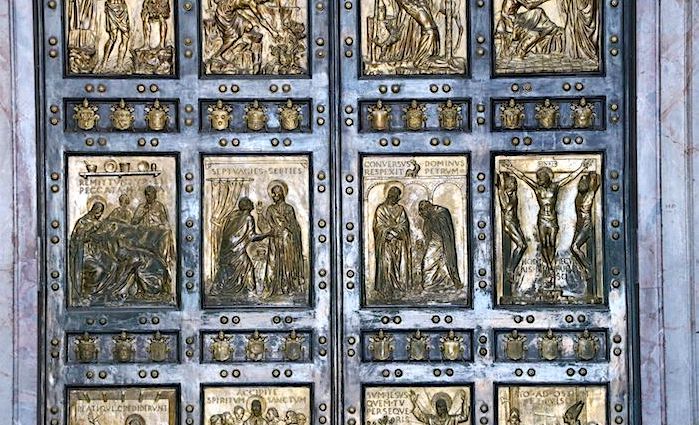
Vico Consorti | 1950 | Bronze | Atrium Before Entering Church
The holy door is opened during the holy year or Jubileum. According to a description in 1450 by a certain Giovanni Rucellai of Viterbo, Pope Martin V opened the first holy door in 1423 at the church San Giovanni in Laterano.
The first notes we have of the opening of a holy door at St. Peter’s Basilica are from 1499 during Christmas by Pope Alexander VI. For the next 450 years, the rituals involved with the opening and closing of the holy door have remained unchanged.
The minute details of what has changed will be reserved for another article. Suffice to say that this is one of the more interesting rituals of the Catholic Church over the centuries.
If you happen to be in Rome during a Jubiluem (every 25 years—the next one scheduled for 2025), you’ll find the holy doors open. Take advantage of it and walk through!
Pope Boniface VIII, named by Dante in the Divine Comedy, proclaimed the first Holy Year or Jubilee in 1300, to invite pilgrims to Rome for special indulgences.
Enrico Bruschini, Art Historian and Official Vatican Tour Guide
6. The Paintings (Or Mosaics?)
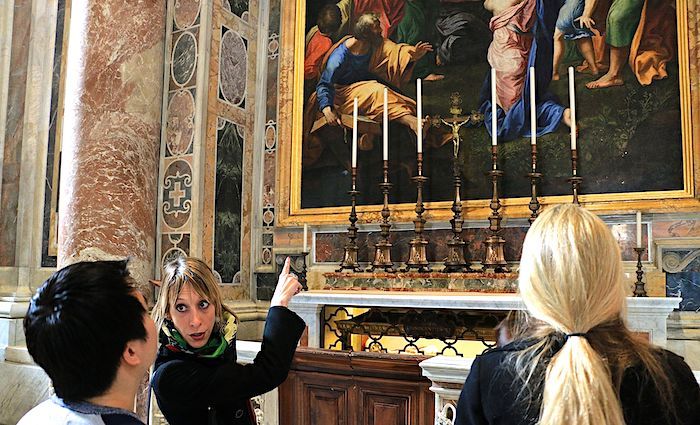
Various Mosaic Artists | 19th Century | Mosaic | Interior
I will let you in on a little secret about the paintings in St. Peter’s Basilica. There are no paintings! They are all actually glass or ceramic mosaics. In the 19th century, the many paintings that were in the church were beginning to deteriorate due to the humid conditions inside the basilica.
This is why when you’re in the basilica, you can take photos with a flash because you’re taking a picture of glass and not of a painting so no damage will be done. You have to get up very close to the picture in order to see the glare of light on it and the little squares of glass and ceramic. It’s a great surprise to show your friends when you’re there.
Popular Vatican Tours
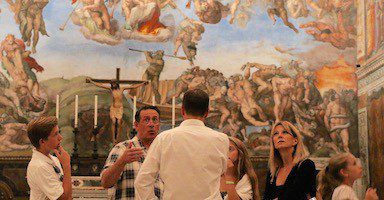
Best Selling Tour
Privileged Entrance Vatican Tour with Sistine Chapel
This our most popular and longest-running Vatican tour to date. It enters the Vatican City & Museums an hour before the public opening and visits the Sistine Chapel as it opens. Admissions are included and our English-speaking guides do a wonderful job bringing the museums to life! Admissions included.
See Prices
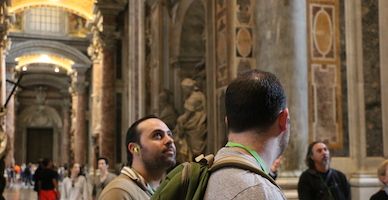
Best Price!
Skip the Line Vatican Tour with Sistine Chapel & St. Peter’s Basilica
One of our most popular Vatican tours since it is such an amazing value. Skip the line to get inside with a super-knowledgeable English-speaking guide that will bring the museum to life. Stories of the artists, popes, conspiracy, love, and of course tragedy! Admissions included.
See Prices
Not ready to book a tour? Check out our best Vatican tours to take and why.
5. The Obelisk
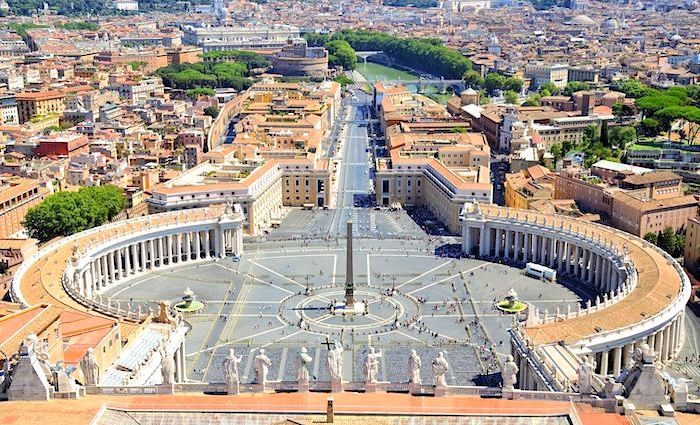
Unknown Artist | 1985 B.C. – 1929 B.C. | Red Granite | St. Peter’s Square
In the middle of St. Peter’s square, you’ll see a giant piece of red granite. This is called an obelisk and if you pay attention, you’ll see quite a few of them around Rome. This particular obelisk was originally erected in the middle of the spina or central area of Nero’s Circus. It’s one solid piece of stone 82 feet (25 meters) high and weighs 330 tons!
It’s the second-highest in Rome, after the one at St. John of Lateran church, and surprisingly is the only one without hieroglyphs. The writing you find on it is actually in Latin. It was erected by the Pharaoh Amenemhet II (1985 to 1929 B.C.) as a votive offering for recovering his eyesight.
In A.D. 40, Emperor Caligula wanted it in Rome and so that’s how it ended up in the Eternal City. When the new St. Peter’s church was built, the obelisk was still in its original position. At that point, Pope Sixtus V had it moved to the center in front of the new church. He also put a cross on top for good measure.
4. Loggia delle Benedizioni (Loggia of the Blessings or Central Balcony)
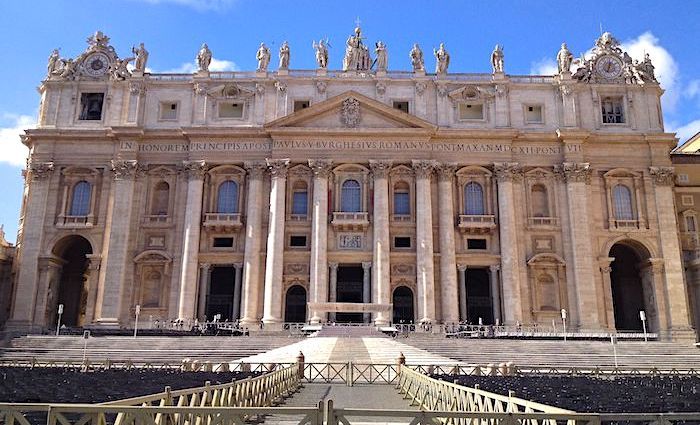
Carlo Maderno | 1607 – 1614 | Travertine | Facade of Church
If you look at the facade of St. Peter’s Basilica, you’ll notice a huge balcony right smack in the middle of it. There are two important events that take place here:
- The Solemn Benediction Urbi et Orbi: These are yearly occasions during Christmas and Easter. The Latin words mean “to the city” and “to the world,” so basically it means to everyone.
- The Announcement of a New Pope: When a pope passes away, all the cardinals group together in the Sistine Chapel for the Conclave. This is when a secret vote happens to elect a new pope. Once the pope is elected, white smoke will appear from the Sistine Chapel, letting everyone in St. Peter’s Square know that a new pope has been elected. A little while later, the Cardinal Protodeacon will appear and announce the new pope with the famous phrase Habemus Papam!
Curious what else happens during the Papal Conclave? Check out our article on What Happens When a Pope Passes Away?
3. La Pietá
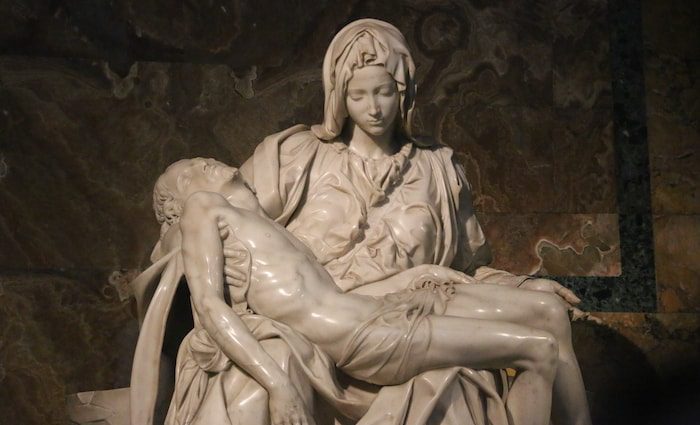
Michelangelo | 1497 | White Marble | Interior
By now, you realize that Michelangelo could do anything. He painted the most famous painting in the world (Sistine Chapel), he built the biggest dome (St. Peter’s), and he made great sculptures!
In 1497, the French ambassador to the Holy See, Cardinal Jean de Bilhères-Lagraulas, commissioned Michelangelo to sculpt a full-size statue of La Pietà. Michelangelo wasn’t yet well known and therefore set about, with a single piece of Carrara marble, to create one of the most famous statues of all time.
The statue captures the moment when the Virgin Mary holds a recently crucified Jesus in her arms. The powerful scene is compounded by her look of extreme sadness together with his completely collapsed body on her lap.
It’s hard to believe that this object is made from hard, marble stone just by looking at it. The Master was able to soften each feature and make the marble look “soft.” Even more incredible is the fact that he did all of this with only a hammer and chisel!
Due to the fact that he was so unknown as an artist when he unveiled the masterpiece, people attributed the statue to an artist from Milan. That night, he went to the statue and actually carved his name where you see the sash of Mary, writing “Michelangelo from Florence made this.” This is even more remarkable since he wasn’t known to leave his signature on any of his art pieces.
2. Baldacchino
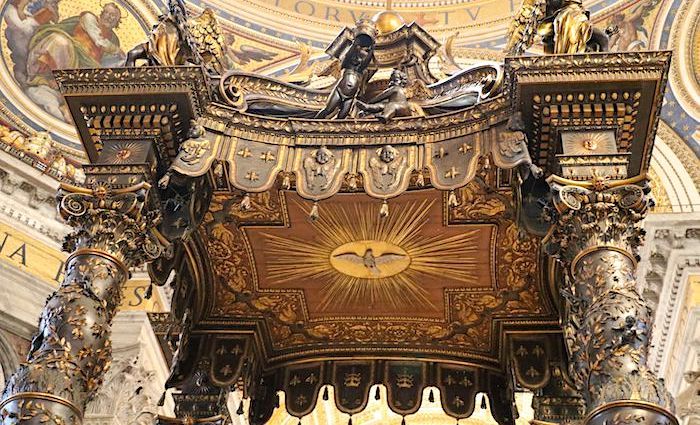
Gian Lorenzo Bernini | 1624 – 1633 | Bronze | Interior Above High Altar
Bernini started working on this at just 26 years old. The high altar of St. Peter’s Basilica is the main altar of the church where only the pope is allowed to stand and give mass.
The Baldacchino is a canopy that hovers over the high altar, which has been used since Medieval times. With the advent of the baroque age, things were taken to new heights (literally) as we will see.
Once the basilica was finished, it would have appeared that something was still missing in the church. There was no connection between the long nave by Carlo Maderno and the massive dome by Michelangelo.
So, Pope Urban VIII commissioned Gian Lorenzo Bernini to create the Baldacchino to cover the high altar. It was to be made of bronze and, like everything else in the baroque period, should be monumental.
Bernini created a canopy of bronze with spiraling columns. Bernini’s inspiration for the columns was taken from a similar style of columns that were situated in the Basilica of Constantine.
The actual height is an astonishing 95 feet (28 meters) high. The material used to make this was taken from the porch roof of the Pantheon. As you approach the center of the church, your eyes naturally gaze up at the Baldacchino and continue their trajectory up to the top of the dome.
1. High Altar (Tomb of St. Peter)
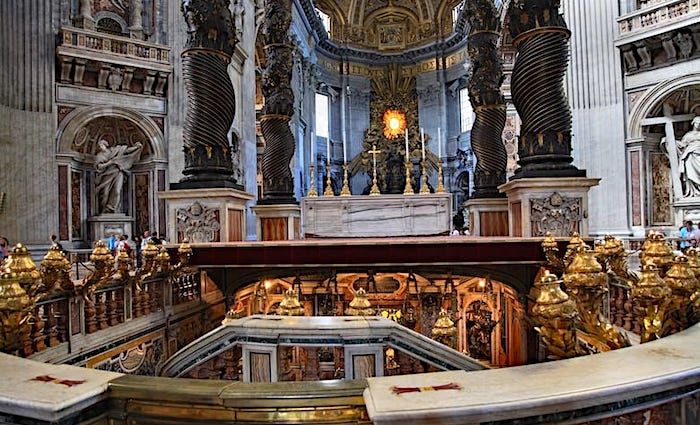
Carlo Maderno | 1615 | Colored Marble | Interior
Below the Baldacchino, you have what is called the High Altar (so called because only the pope is allowed to give mass there or someone he has personally appointed). Its location is such since below that is the Confession or the area dedicated to the tomb of St. Peter.
To descend, there is a double ramp with 16 stairs that lead down into the Confession. You’ll find many different colors of marble decorating the walls. According to the official website, this was the most important work, architecturally speaking, of hard stone done in Rome in the 1600s and the last work of such magnitude and richness executed in this technique.
The word Confessio in Latin expresses the affirmation of truth until death since when a martyr spills his blood for Christ, he confesses and proclaims his faith in a supreme act
Official website of St. Peter’s Basilica
Not ready to book a tour? Find out if a Vatican tour is worth it.
Here’s Where To Stay in Italy’s Most Popular Destinations
Rome, Florence, Venice, Amalfi Coast, and Capri

